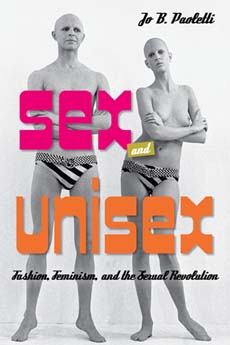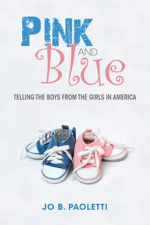The story of gendered clothing for our youngest children is still unfolding, and will probably never be finished. Each generation learns a new set of rules, devised by the grown children of the previous generation. Each wave of parents dresses their sons and daughters in ways that represent their own memories and their present lives as men and women. Babies grow up, not in the parents’ cultures, but in their own, changing it by their very presence. Someday babies may be raised more as “persons” and less as “boys” and “girls” but that has not been our trajectory for more than one hundred years. In the meantime, if anyone wants to observe the most obvious, seemingly immutable gendered aspects of our culture, visit a class of four-year-olds. Existing in the time between awareness of their sex and security in its expression, they enact every rule they observe with uncanny precision. By the time they reach their teens, they will be twisting and stretching the rules that vex them the most. Then they will become adults (and parents) and the dance goes on.
|
This is the first draft (and therefore ROUGH!!) if the last paragraph of my concluding chapter. Comments and suggestions most welcome.
The story of gendered clothing for our youngest children is still unfolding, and will probably never be finished. Each generation learns a new set of rules, devised by the grown children of the previous generation. Each wave of parents dresses their sons and daughters in ways that represent their own memories and their present lives as men and women. Babies grow up, not in the parents’ cultures, but in their own, changing it by their very presence. Someday babies may be raised more as “persons” and less as “boys” and “girls” but that has not been our trajectory for more than one hundred years. In the meantime, if anyone wants to observe the most obvious, seemingly immutable gendered aspects of our culture, visit a class of four-year-olds. Existing in the time between awareness of their sex and security in its expression, they enact every rule they observe with uncanny precision. By the time they reach their teens, they will be twisting and stretching the rules that vex them the most. Then they will become adults (and parents) and the dance goes on. By way of apology for my lack of posts while I finish my manuscript (August 30 deadline whooshing towards me!), I offer the latest salvo in the Nature vs. Nurture battle.
(Male and female ability differences down to socialisation, not genetics (Guardian, UK, 8/15/2010) I just got a great email from commenter Andi, AKA "Feministjerk" (no, he really isn't!). He offered an expansion of his theory that the connection between pink and femininity is the result of post-World War II capitalism and branding. I think he's partially right, but one of the arguments I make in the book is that children themselves are actors in the process, and any theory that does not take children into consideration as consumers is going to be incomplete. The more adults have listened to -- and marketed to-- children, the more clothing for children under the age of six has become gendered. The typical 4-year-old is about the most ardent believer in gender stereotypes you can find, because that is where they are developmentally. Thus the princess craziness, for example. Disney knows 3-6 year-old girls.
As infants grow into toddlers, they become active participants in the gender binary fashion show, much to the amusement, chagrin or dismay of their parents. For boys and girls whose gender identity generally conforms to their biological sex, this participation appears likely to be enthusiastic embrace. These are the girls who insist on wearing nothing but pink and prefer dresses to any form of pants, and the boys who clamor for buzz-cuts and ubiquitous sports imagery. One of the most puzzling questions raised by the gendered clothing of the last generation is, “What about the others?” What about tomboys, the little girls who for decades could wear plain girls’ styles or their brother’s hand-me-downs without appearing out of the mainstream? (In a study of college age women in the early 1970s, 78% described themselves as “tomboys” as children, though the age to which they referred was unclear.) What about the one person in 100 classified as “intersex”, whose body differs from standard male or female and whose sense of identity may not conform to the gender chosen for them by their parents? What about boys who, like tomboys, feel more comfortable in the clothing of the other sex, but for whom the English language has no positive term? Certainly, one of the outcomes of a strong gender binary in children’s clothing is the lack of expressive options for children whose identities may be more fluid or contrary to stereotyped images of masculinity and femininity. According to recent research, 41% of expectant parents are choosing not to find out the sex of their baby before it's born. Many of those who do would prefer to have it both ways: keep the surprise but also get gender-specific gifts for their offspring. A Texas entrepreneur has solved the problem with an online gift registry that caters to these "NFO" parents. This video explains how it works.
I am finding in my research that planning and purchasing is one of the top reasons for finding out the baby's sex in advance. Of course, the question remains: why does having the right pink or blue wardrobe matter so much, at 20 weeks or 40? Over the last 25 years, baby clothes have become increasingly gendered, and neutral options have nearly vanished. Certainly one reason is the technology that allows us to know a baby's sex with nearly 100% certainty long before birth. As a costume historian, my interest is not only in what people choose to do with that information, but how they react to the choice itself. I am hearing from more and more expectant parents who choose NOT to know; not surprisingly, these are also the folks who are the most vocal about the lack of neutral styles and about stereotypical gender binary design. They not only want to wait until birth to know if they are having a son or a daughter, but even then they want to avoid pink, girly things and "little man" outfits.
At the other extreme are parents who embrace early sex identification, because it makes preparations (not only clothing, but nursery designs and naming) more convenient, or because they feel it helps them connect with the baby as a "real" person. For these folks, there is an industry eager to provide the information they crave. I was tipped off to the existence of First Glimpse by references and recommendations in several pregnancy blogs. This is more than the sonograms once used primarily to detect potential problems, which could sometimes also detect genetalia. What was incidental is now central, in First Glimpse's "Gender Determination" packages. Combining elements of medicine, spa treatments, scrapbooking and glamor photography, they offer women a pregnancy experience that is as commodified as a cruise. Maybe that's next. |
Jo PaolettiProfessor Emerita Archives
January 2023
Categories
All
|


